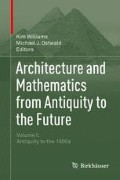Abstract
In architecture, systems of proportions facilitate technical and aesthetic requirements, ensure a repetition of ratios throughout the design, have additive properties that enable the whole to equal the sum of its parts, and are computationally tractable. Three systems of architectural proportion meet these requirements: a system used during Roman times, a system of musical proportions used during the Renaissance, and Le Corbusier’s Modulor. All three draw upon identical mathematical notions already present in the system of musical proportions. While the Roman system is based on the irrational numbers √2 and θ = 1 + √2, the Modulor is based on the Golden Mean, ϕ = (1 + √5)/2. Both can also be approximated arbitrarily closely (asymptotically) by integer series. Underlying the Roman system is the “law of repetition of ratios” and the geometrical construction known as the “Sacred Cut,” both of which geometric expressions of the additive properties of the Roman systems and ensure the presence of musical proportions. The discussion concludes with a system of “modular coordination” based on both musical proportions of Alberti and Fibonacci numbers.
First published as: Jay Kappraff , “Musical Proportions at the Basis of Systems of Architectural Proportion both Ancient and Modern”, pp. 115–133 in Nexus I: Architecture and Mathematics, ed. Kim Williams, Fucecchio (Florence): Edizioni dell’Erba, 1996.
Access this chapter
Tax calculation will be finalised at checkout
Purchases are for personal use only
References
Alberti, Leon Battista. 1755. The Ten Books of Architecture. Rpt. NewYork: Dover Publications, 1986.
Brunés, Tons. 1967. The Secrets of Ancient Geometry – and Its Use. Copenhagen: Rhodos.
D’Ossat, Guglielmo De Angelis. 1984. La Sagrestia Nuova. In Umberto Baldini and Bruno Nardini, eds. San Lorenzo. Florence: Nardini Editori.
Edwards, Edward B. 1967. Pattern and Design with Dynamic Symmetry. Originally published as Dynamarhythmic Design (1932). New York: Dover Publications.
Ehrenkrantz, Ezra. 1956. Modular Number Pattern. London: Tiranti.
Hambidge, Jay. 1967. The Elements of Dynamic Symmetry (1926). New York: Dover Publications.
___. 1979. The Fundamental Principles of Dynamic Symmetry as They are Expressed in Nature and Art Albequerque: Gloucester Art Press.
Kappraff, Jay. 1990. Connections: the Geometric Bridge between Art and Science. New York: McGraw–Hill.
___. 1996a. Linking the Musical Proportions of the Renaissance with the Modulor of Le Corbusier and the System of Roman Proportions. International Journal of Space Structures 11, 1 and 2.
___. 1996b. Mathematics Beyond Measure: Essays in Nature, Myth, and Number. New York: McGraw-Hill.
Scholfield, P.H. 1958. The Theory of Proportion in Architecture. New York: Cambridge University Press.
Watts, Donald .J. and Watts, Carol. M. 1986. Roman Apartment Complex. Scientific American 255, 6, (Dec. 1986): 132-140.
Williams, K. 1994. The Sacred Cut Revisited: The Pavement of the Baptistry of San Giovanni, Florence. The Mathematical Intelligencer 16, 2 (Sp. 1994): 18–24.
___. 1997. Michelangelo’s Medici Chapel: The Cube, the Square, and the √2 Rectangle. Leonardo. Journal of the International Society of Arts, Sciences and Technology 30, 2 (1997): 105-112.
Wittkower, Rudolf. 1971. Architectural Principles in the Age of Humanism. New York: Norton.
Author information
Authors and Affiliations
Corresponding author
Editor information
Editors and Affiliations
Rights and permissions
Copyright information
© 2015 Springer International Publishing Switzerland
About this chapter
Cite this chapter
Kappraff, J. (2015). Musical Proportions at the Basis of Systems of Architectural Proportion both Ancient and Modern. In: Williams, K., Ostwald, M. (eds) Architecture and Mathematics from Antiquity to the Future. Birkhäuser, Cham. https://doi.org/10.1007/978-3-319-00137-1_37
Download citation
DOI: https://doi.org/10.1007/978-3-319-00137-1_37
Published:
Publisher Name: Birkhäuser, Cham
Print ISBN: 978-3-319-00136-4
Online ISBN: 978-3-319-00137-1
eBook Packages: Mathematics and StatisticsMathematics and Statistics (R0)

